Abstract
The article discusses a controversial issue of the alternate consideration of the semantics of syntactic units in the positions of homogeneous clause components. The authors of the article believe that the leading role here is played by the nuclear predicative link, which introduces nuclear components into the sentence. The article argues that it is necessary to take into account the syntactic status of the nuclear predicative links and the syntactic content of syntaxemes provided by it in the positions of homogeneous clause components. In addition, the authors question the possibility of coordinative link to influence the semantic content of syntaxemes. Taking into account all these factors, the authors of the article refute the controversial issue of the alternate consideration of the semantics of syntactic units in the positions of homogeneous clause components. Thus, the dual character of categorical features of syntaxemes is established in the subject position, namely the nuclear predicated component of the sentence. At the same time, the status and role of the coordinative link in organizing the structure of sentences with homogeneous components are not questioned. The article uses the methods of linguistic experiment and modeling of syntactic links using the junction models of the sentence.
Keywords: Coordinate link, elementary syntactic units, junction model, syntactic link, syntactic semantics
Introduction
Sentences of coordinate link are rarely considered in practical grammars. Difficulties in determining the semantics of syntaxemes in the subject position are associated with the presence of homogeneous clause components in the sentence introduced by a coordinative syntactic link. However, such types of sentences are analyzed by scientists in particular, because in these sentences the syntactic and semantic features of elementary syntactic units are interconnected. Doroshenkov (2012) researched semantics of syntactic units in the positions of homogeneous clause components.
Peshkovsky (1956) paid considerable attention to sentences with homogeneous parts in his famous “Russian Syntax in Scientific Research Coverage” in Russian Linguistics. He researched sentences that combine seemingly incompatible parts of the sentence – subject and subordinate part of the sentence.
Peshkonsky considered conjunction to be the main formal means of coordinate links. Conjunctions bring two representations into connection with each other and connect them with the supporting third one. Thus, conjunction is “a word expressing homogeneity of two parts in relation to the third one” (Fursova & Velichko, 2016, p. 219).
All the sentences with homogeneous parts are called fused according to Peshkovsky. The homogeneity is opposed to the “real” meaning of the word. And the more vivid the “real” meaning of the word, the more complex the conflict between meaning and homogeneity.
In such a sense-centric analysis both syntactic content of clause components and syntactic-semantic content of syntaxemes are out of the scope of the study. According to Mukhin (1999), syntaxeme “is a syntactic unit, represented by its variants – by lexemes as well as syntactically not divided combinations of lexemes with word-forms or without them. Its content is syntactic: i.e. distinctive syntactic-semantic features” (p. 12). According to Zolotova (2001) “syntaxeme is an elementary syntactic unit” (p. 20). In the article, syntaxeme is considered as a semantic and syntactic unit. Syntactic characteristics of syntaxeme is based on “its syntactic function” (Vanchikova, 2016b, p. 85) and the position in the sentence. Liubchenko and Shramko researched actional and objective syntaxeme in the semantic and syntactic structure of a sentence (Liubchenko, 2020; Shramko & Rakhno, 2019). Sulaymanova studied locative syntaxemes in the English language (Sulaymanova, 2012), (Sulaymanova, 2016). Vanchikova (2016a) researched actional, stative syntaxemes.
Problem Statement
Syntactic-semantic content of syntaxemes differs from syntactic content of clause components. Semantically different syntaxemes are commonly observed in the positions of homogeneous clause components. This is misleading when determining syntaxeme semantics in the subject position since their semantics is set taking into account not a coordinate but nuclear predicative link.
Research Questions
The main objective is how to determine the syntactic-semantic content of syntaxeme in the subject position. What are the syntaxeme characteristic features? And what are the methods to attain the objective?
Purpose of the Study
The main purpose is to establish a methodology to identify syntactic-semantic content of syntaxemes in the subject position in the sentences with homogeneous clause components introduced by the coordinate link.
Research Methods
The analysis of the research material is carried out within the framework of the theory and methods of linguistic analysis developed by Mukhin (2004). The main methods used in the article are linguistic experiment and linguistic modeling of sentences using junction models or, in other words, models based on the syntactic link. “Exemplification of the model is carried out through linguistic experiment” (Sinitsyna, 2008, p. 159). “Syntacsemic analysis is mainly based on three classifying features: substantial, processual and qualificative” (Ashurov, 2020, p. 4580).
Findings
Intensive studies of syntaxemes in the 20th century were caused by the need to develop more precise syntactic units than parts of the sentence. As a result of different research, two types of syntactic units were developed: clause components and syntaxemes. Clause components are mainly built on parts of the sentence, but their definition is based on the syntactic not semantic principle. The notions of parts of the sentence (mainly subject and predicate) are sometimes used in the linguistic discourse asshort names of syntactic units.
From another point, syntaxemes are new syntactic units previously unknown to scientists. These days they are aconsiderable field of elementary units (syntactically non-divisible further) which are successfully used in the researches of syntaxemes. Precise naming of syntactic units contributes to an adequate description of the observed phenomena.
When analyzing fused sentences, we can observe them fall into two types. In sentences of the first type, syntaxemes, which are similar in set of features, are in the positions of homogeneous predicates. The content of syntaxemes in subject position in such sentences is identified unambiguously.
We consider the sentenceand build a junction model of this sentence (or the model of its syntactic links):
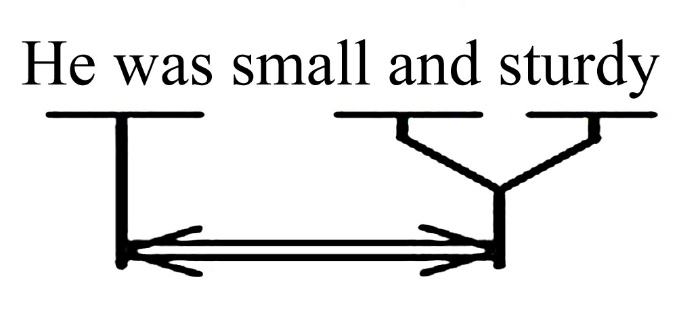
We can conclude that this model indicates that there is a coordinate link between the second and the third clause components, and there is a nuclear predicative link between these (the second and the third) components and the first one. The nuclear predicative link introduces homogeneous clause components and a coordinate link into the sentence. Based on these two links, the syntactic features of clause components can be analyzed. The first component –is nuclear predicated (NP1), as it is specular predicated these features from the second two components which are homogeneous predicating (HNP2 * HNP2). This is structural syntax.
The content of syntaxemes in the positions of these clause components is different. If we conduct an experiment, one of the homogeneous components will be omitted and thereby the coordinate link will be removed:(Figure 2) there is a model of a dual-nuclear unextended sentence:
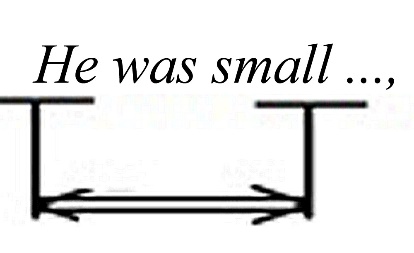
Taking into account nuclear predicative link it is determined that the substantial syntaxeme of quality (SbQlt) is in the subject position (nuclear predicated clause component- NP1), and qualitative syntaxeme (from the class of qualifying) – (QlfQlt) is in the predicate position (NP2).
As a result of this analysis the syntaxeme model of the first sentence is:
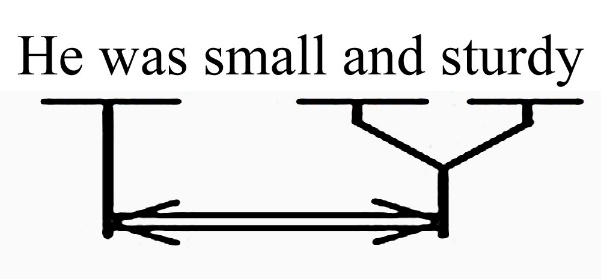
In the sentences of the second type, different syntaxemes are in the positions of homogeneous predicates. For example: (2) She was elegant and smiling; (3) The windows were high and many; (4) The book is sturdy and a good buy; (5) He was elegant and bowler-hatted; (6) You were born poor and on a farm.
In the first of these sentencesthe elementmeans quality, i.e. is a qualitative syntaxeme (from the class of qualifying), the elementmeans action, i.e. is an actional syntaxeme (from the class of processual).
The question is: should we take the alternate consideration of these different features into account when determining syntactic-semantic content of syntaxeme in subject position? That is, in one case it will be the syntaxeme of quality, in the other – agentive syntaxeme. But such solution does not seem to be justified. Firstly, the speaker, a native speaker, deliberately combines different features, which may be logically incompatible. Secondly, there are many sentence models in the language in which characteristic of syntaxemes in subject position is determined on the basis of two syntactic links, as a result of which the syntaxeme is given semantically different features.
These are some examples along with corresponding junction models:
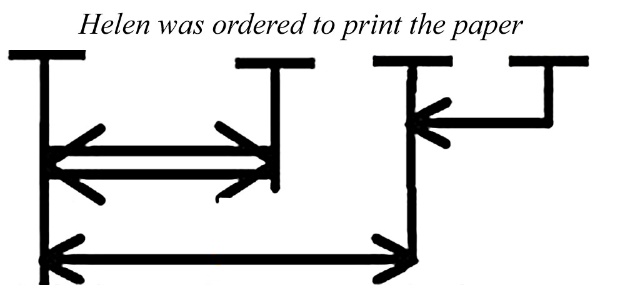
In this sentence, the content of the elementis identified on the basis of two syntactic links – nuclear predicative and non-nuclear predicative, - as substantial objective agentive syntaxeme (SbObAg).
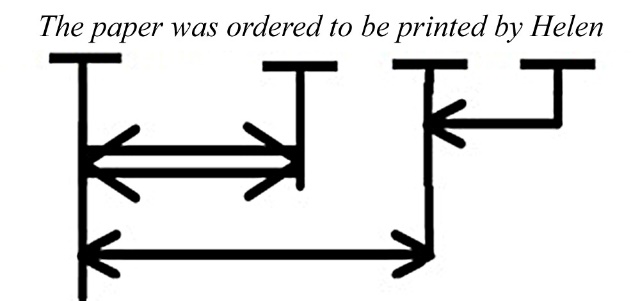
In this sentence, the form of the second predicate is changed, and accordingly, the content of the syntaxeme in the subject position has changed. is substantial double objective syntaxeme (SbObOb).
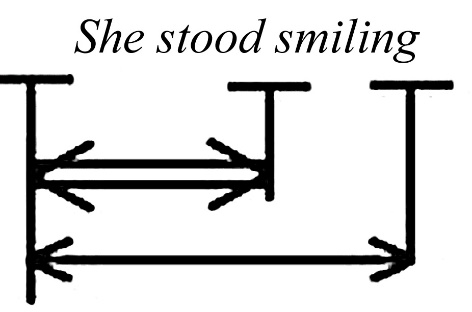
In this sentence, the first syntaxeme is also identified taking into account two syntactic links as a substantial double agentive syntaxeme (SbAgAg).
Taking all the factors into account it is believed that in case of combining two syntactic links – nuclear predicative and coordinate, synsematic features of syntaxemes in subject position should be determined similarly to the above examples. In other words, there is no need to separately consider the features of syntaxemes.
The idea to alternately define the synsemantic content of the syntaxeme in subject position occurred to Mukhin (2007) when analyzing the sentence:In this sentence, two absolutely different syntaxemes are in the position of homogeneous clause components. Both having different content and different formal features: the elementmeans state and is a stative syntaxeme (from the class of qualifying). It combines with comparative elements and this combinability confirms the semantics of stativity, i.e.:The elementmeans action, i.e. is an actional syntaxeme (from the class of processual), which combines with objectiveand locative syntaxemes, with which stative syntaxeme cannot be combined. The semantics of these two syntaxemes must be considered when determining the content of syntaxeme in subject position, since these syntaxemes are introduced into the sentence by a nuclear predicative link.
As illustrated above, the second syntactic link cannot provide grounds for alternate consideration of features and separate characteristics of the syntaxeme in subject position. This contradicts the text of the sentence in which the elementhas two features: of state and of action, i.e.is defined as agentive syntaxeme of state (from the class of substantial). As a result, separate consideration of features leads to two different versions (two separate sentences) in the experiment:.
We can identify the elementas a substantial agentive syntaxeme of state (SbAgSt). Thus, there exists the possibility of defining semantics of syntaxemes in the subject position (NP1) in the sentences with the coordinate link.
Conclusion
Based on the researched methods it was found that when defining the semantics of syntaxemes in subject position in the sentences with homogeneous predicating components, the content of these syntaxemes is reduced to a combination of dual categorical features and cannot be split. At the same time, the role of the coordinate link is not questioned.
The assumption of alternate determining of features fails the test of linguistic experiment and linguistic modeling adopted in linguistic analysis. Experimentally it is not possible to build a junction model of syntactic links of a sentence in which links and featured are considered alternately. In our last experiment, the coordinate link is lost but the features remained. It means that the coordinate link does not compel the idea of alternate consideration of features. In the sentences with the coordinate link more often than in many others, there are syntaxemes with seemingly illogically incompatible features.
When defining the semantics of syntaxemes in the subject position in the sentences with coordinate link it is inappropriate to alternately consider the semantic content of syntaxemes in the position of homogeneous clause components. This leads to the dismemberment of the semantics of syntaxeme in the subject position.
References
Ashurov, S. S. (2020). Some comments on the analysis of active and stative syntaxeme in the function predicate. Journal of critical reviews, 7(18), 4580-4583.
Doroshenkov, V. A. (2012). On the semantics of syntaxemes in positions of homogeneous clause components. Krasnodar. Cognitive- discursive research of the language and linguistic analysis.
Fursova, L. V., & Velichko, V. (2016). Conjunction means of the Russian language. Tavrichesky Scientific Observer of the Russian Language, 1-3(6), 219-220 https://cyberleninka.ru/article/n/soyuznye-sredstva-russkogo-yazyka
Liubchenko, T. (2020). Predicate and Objective Syntaxeme in the Semantic and Syntactic Structure of a Sentence in Modern Greek. Scientific Journal of National Pedagogical Dragomanov University, 9, 90-108. Current Trends in Language Development. DOI:
Mukhin, A. M. (1999). Functional syntax. Science.
Mukhin, A. M. (2004). Experiment and Modeling in Linguistics. Structural syntax of a sentence. Science.
Mukhin, A. M. (2007). Functional syntax. Functional lexicology. Functional morphology.
Peshkovsky, A. M. (1956). Russian syntax in scientific coverage (7th ed.). Science. https://www.prlib.ru/item/363106
Shramko, R., & Rakhno, M. (2019). The Issue of Lexical and Grammatical Representation of the Object Syntaxeme in Sentences with Subject Attitude Predicates – Constituents of Isofunctional Two-/Three component Syntactic Paradigms. Linguistic Studies. Vol. 37. Section III. Theoretical Issued of Syntax. 2019. P. 49-55. DOI:
Sinitsyna, Yu. N. (2008). Interpretation potential of discourse [Doctoral dissertation, Kuban State University].
Sulaymanova, N. J. (2012). Research methods of locative element. International Research Journal. https://research-journal.org/en/philology/resaerch-methods-of-locative-element/
Sulaymanova, N. J. (2016). Locativeness and ways of its expression in the English and Uzbek languages. International Journal of Advanced research, 4(10), 710 715. http://www.journalijar.com/uploads/57_IJAR-12883.pdf
Vanchikova, E. A. (2016a). Syntaxeme as structural element of a French sentence. Roman cultural heritage: history and modern times, 281-285.
Vanchikova, E. A. (2016b). The role of the syntaxeme in predicative relations. Tambov. Philology. Theory and Practice, 11(65), 84-86.
Zolotova, G. A. (2001). To the problem of correlation of semantics, morphology and syntax. St. Petersburg. Theoretical problems of functional grammar, 19-20.
Copyright information

This work is licensed under a Creative Commons Attribution-NonCommercial-NoDerivatives 4.0 International License.
About this article
Publication Date
02 December 2021
Article Doi
eBook ISBN
978-1-80296-117-1
Publisher
European Publisher
Volume
118
Print ISBN (optional)
-
Edition Number
1st Edition
Pages
1-954
Subjects
Linguistics, cognitive linguistics, education technology, linguistic conceptology, translation
Cite this article as:
Doroshenkov, V. A., Sinitsyna, Y. N., Tikhonova, S. A., & Mayorova, A. S. (2021). On The Semantics Of Syntactic Units In Subject Position. In O. Kolmakova, O. Boginskaya, & S. Grichin (Eds.), Language and Technology in the Interdisciplinary Paradigm, vol 118. European Proceedings of Social and Behavioural Sciences (pp. 30-36). European Publisher. https://doi.org/10.15405/epsbs.2021.12.5

